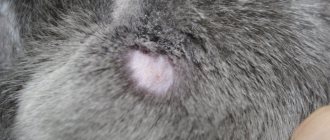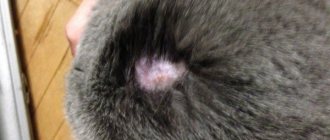Possible causes of itching
Often, a domestic cat often washes and scratches its neck behind the ears, its muzzle, tears the skin on its head and scratches itself so that its hair falls out or sores appear until it bleeds and scabs and scabs, and to find out why this happens and how to treat it, first The first thing you need to do is check whether he has fleas or not.
If blood-sucking insects or their eggs are detected, you will need to immediately treat the animal’s fur with special preparations. Even after the parasites are completely eliminated, the body still contains the substance that entered the bloodstream during the bite. Its effect can last from 1 to 2 months, causing the cat to want to scratch the irritated area. If no fleas were found during examination of the animal, then the cause of the itching may be as follows :
- skin diseases;
- hormonal disbalance;
- allergic reaction;
- endocrine gland disorder;
- lichen;
- the presence of parasitic worms (helminths).
To eliminate itching and protect a cat living at home from scratching its neck, back and other places, it is necessary to identify the source of its occurrence and carry out effective treatment. Next, the possible causes of the disease are discussed and what to do if the cat often licks itself until it hurts, what to give if it is constantly itching.
If all else fails
The most difficult moment for a loving owner is when he tries different methods one after another, but nothing works. The cat has a sore on her neck, a blood scab, which is also beginning to rot. Until you find the cause, you need to fight at least the effect so as not to trigger the disease. In this case, it is best to choose “Amidel”. They help dry wounds very well and relieve inflammation. But the effect will be temporary, since we have not yet eliminated the cause. However, it is important not to make the situation worse with sepsis, so continue to look for treatment options and in the meantime, keep using the spray or ointment.
Itching caused by helminths
There are a large number of varieties of parasitic worms that take up residence in a cat’s body. They can be:
- round;
- flat;
- tape.
Usually at the very beginning of infection it is difficult to consider any of its symptoms, but after a while the animal:
- loses appetite and activity;
- becomes restless;
- Constantly licks and itches.
Worms found in the intestines are considered almost harmless.
Difficulties with your pet’s health arise when there are too many helminths and their larvae begin to migrate.
The movement of worms throughout the animal’s body is accompanied by the following symptoms:
- sudden weight loss, increased fatigue, growth retardation in small pets;
- disheveled wool;
- enlarged liver and icteric staining of visible mucous membranes;
- disruption of the digestive system, expressed in constipation, vomiting, diarrhea;
- appearance of cough;
- discharge from the eyes;
- itching in the anus;
- presence of blood in feces;
- premature birth or miscarriage in cats;
- convulsions and paresis of the limbs.
The cat may not notice the presence of parasites in the body in small quantities. However, their increase will not only exhaust the animal, but will also lead to its death. The harm caused to pets by worms can be completely different :
- eating lymph, tissue and blood;
- release of substances that promote intoxication;
- damage to the mucous membranes by suction cups, leading to internal bleeding.
After the worms die, decomposition products are formed that poison the animal’s body.
The appearance of parasites leads to metabolic disorders, as a result of which the cat’s skin becomes dry and dandruff appears on it. Just like an allergic reaction, these factors are accompanied by itching, which causes the animal to scratch its neck until it bleeds. A pet can become infected with helminths in the following ways :
- eating raw meat or fish (especially river fish);
- flea bites;
- contacts with other animals.
To prevent itching, which causes painful scratching, animal owners need to regularly take a preventive course using anthelmintic medications.
Ringworm and other types of skin mycoses
Ringworm is a skin disease accompanied by:
- the formation of a small rash;
- damage to fur and claws.
This disease can occur due to a viral infection or reduced immunity of the animal.
There are the following factors that contribute to the development of lichen in pets living at home:
- walking outside without supervision;
- treatment with immunosuppressants;
- malnutrition;
- parasite infection;
- malignant formations.
The most common causes of ringworm in cats are those caused by fungal infections. There are several types of lichen:
- Ringworm , which is based on fungal diseases. This type is easily transmitted to humans, especially to young children. Fungal spores remain viable for 5-10 years because they are resistant to environmental influences.
- Versicolor or pityriasis versicolor , which is a dangerous disease. The cause of its occurrence is a yeast-like fungus, which under certain conditions transforms into a pathogenic form.
- Shingles or pink appearance , which appears when immunity decreases and is of an allergic nature.
- Eczema or tinea versicolor manifests itself in animals as an allergic reaction to a specific irritant and is not transmitted through contact with humans or other animals. Allergies can be caused by exposure to household chemicals, a malfunction within the body, or stress.
All types of lichen in cats have common symptoms.:
- hair loss;
- inflammation of the skin accompanied by peeling;
- change in pigmentation;
- severe scabies.
If you suspect lichen, the cat must be isolated immediately . A glazed balcony, loggia or separate room is suitable for this; you need to make sure that the room is warm. After this, you need to contact a veterinarian to establish through diagnostics the cause of the cat’s itching and methods of treating it.
To prevent such diseases from occurring in cats, it is recommended to periodically vaccinate them for preventive purposes.
Sores on a cat’s neck under the fur: Where to go?
Moscow:
- Movet . The clinic is open 24 hours a day. Performs all types of modern research. It is also possible to call a doctor at home.
- Veles . 30% discount on service for guide dogs. There are also other promotions. Unfortunately, specialists do not work around the clock, but this does not affect the quality of services.
Saint Petersburg:
- Elvet clinic network . I work around the clock. It is worth keeping an eye on constantly updated promotions and discounts on the website.
- Veterinary Clinic named after. Ivan Fillmore . Separate entrance for domestic and stray animals. This does not affect the quality of the services provided. Our specialists will provide quality care to all patients.
Quantity
Infectious skin diseases
Skin diseases are the most common problems causing problems for cats and their owners.
Most often, this affects pets that occasionally walk outside. Diseases caused by bacterial infections occur in two forms , such as:
- dry, accompanied by the formation of dry scaly plates and crusts;
- wet, expressed in the appearance of ulcers and blisters filled with exudate.
Cats that have suffered serious illnesses, as well as surgical operations, remain immobile for some time, as a result of which they develop bedsores. Tissue necrosis occurs in areas of prolonged contact of the skin with the litter. To prevent this, the animal must be turned over as often as possible, and places where bedsores may form should be wiped with camphor alcohol or disinfectants.
Cats with hypersensitive skin are at risk of developing eczema . The reasons for its occurrence may be different:
- skin damage due to prolonged friction from contact with any object (collars, harnesses, etc.), due to burns and parasite bites;
- consequences of internal disorders in the body (neuropathy): hormonal imbalance, diabetes.
With eczema, the animal's skin develops rashes and blisters . There is a constant itching sensation in the affected areas (including the neck). To treat this disease, various ointments, soothing powders, and antibiotics are used.
A common disease among cats is acne (blackheads). Its cause may be the animal's low immunity, being under stress or improper care. This bacterial infection has a detrimental effect on the sebaceous glands. As a rule, its presence is indicated by rashes in the form of ulcers throughout the animal’s body. The largest accumulation of acne occurs on the cat's chin, neck and lip area.
At the beginning of treatment, the skin is first treated with antiseptic detergents.
Sores on the neck of a cat under the fur: Treatment at home
What can a cat owner do on his own?
- Trim your cat's claws to reduce the risk of injury.
- Also, depending on the location of the problem, in case of severe itching, you can put a bib or blanket on the cat, which can be easily made from a cotton sleeve.
- It won't hurt to treat with flea drops.
- The crusts can be soaked and removed using 0.05% chlorhexedine.
- It is better not to use other medications before seeing a doctor, as this will blur the picture and interfere with diagnosis.
Do cats need to be washed and if so, how? Tips for bathing tailed cats - https://strazhchistoty.ru/cleanup/cleancats/nado-li-myt-koshek.html
Infestation by exogenous insects
Both fleas and other bloodsuckers can parasitize a cat’s body . The presence of these insects leads to the occurrence of various diseases. The most dangerous of them include:
- flea dermatitis;
- mite damage: sarcoptic mange, notoedrosis.
When a flea bites, a wound with their saliva remains on the animal's body, causing severe itching. The cat begins to vigorously scratch the affected area, which leads to the infection getting inside. The inflammatory process in combed areas is manifested by redness and hair loss.
Fleas not only contribute to the occurrence of infectious diseases, but are also carriers of worm eggs (helminths).
When infected with ticks, the clinical picture in cats is as follows::
- severe itching on dry areas of the skin;
- hair loss;
- formation of ulcers on exposed areas.
Notoedrosis in cats is manifested by the presence of Notoedres cat mites and is accompanied by the following symptoms:
- itching and severe scratching;
- rash in the form of blisters;
- the appearance of crusts on itchy areas;
- hair loss;
- loss of skin elasticity, appearance of cracks infected with bacteria and fungi.
Sarcoptic mange occurs in cats due to their infestation with mites of the species Sarcoptes canis .
These tiny bloodsuckers are 0.2-0.4 mm long and have a long proboscis. Thanks to this, they easily gnaw holes in the skin and make a large number of moves in it. Once on the animal's body, the parasites begin to actively lay larvae. In this regard, already 1.5 months after their appearance, their numerous offspring are present on the cat’s body. The main symptom of this disease is severe itching, which gets worse in the evening. First of all, the tick infects areas on the animal’s head, neck, and near the ears, where blisters and redness immediately appear. After a while, these places become covered with dried crusts. The animal becomes restless, constantly itches and meows. Constantly scratching itchy areas, the cat cannot sleep, loses its appetite and experiences weight loss.
Therapy involves not only getting rid of bloodsuckers, but also healing damaged skin areas, as well as restoring the pet’s immune system.
Important! At the first signs of sarcoptic mange, the cat should be shown to a specialist.
Sores under a cat's fur: Symptoms
It can be difficult to notice any changes in the skin under a cat's fur, especially if it is thick and long. Groom your pet regularly - comb it. Then it will be easier to detect the problem at an early stage.
The owner may notice itching. Also, at the site of damage, the fur may fall off in shreds along with the crust. The skin may be red and have an unpleasant odor.
Seborrhea (dandruff) often occurs. You need to pay attention to all these signs and contact a veterinary dermatologist for diagnosis.
Watch the video: Fleas in cats - How to get rid of them, what medications to buy
Allergic reactions
Allergies in pets occur due to an inadequate reaction of the body to substances that enter the body from the environment. This could be dust, pollen, one or more components in food, etc. The disease is usually accompanied by:
- severe itching (especially in the head and neck area);
- increased body temperature;
- hyperemia and hair loss.
Long-term exposure to an allergen leads to the development of asthmatic syndrome, atopic dermatitis and the formation of granulomas containing a large number of eosinophilic leukocytes.
An animal with similar symptoms should be shown to a specialist for the purpose of diagnosis and treatment for itching.
If a cat begins to actively scratch its neck, the owner needs to find out the cause of such discomfort as quickly as possible. Serious skin lesions should warrant a visit to the veterinarian. In most cases, skin diseases in cats do not pose a serious threat to their lives , and their treatment can be done at home.
A cat has lump-shaped sores under its fur: Diagnosis
There is no single test that can be used to immediately make an accurate diagnosis. In some situations, it is even necessary to prescribe empirical treatment.
But first, a cat with sores on its fur will need to undergo tests:
- Exclusion of dermatophytes (lichen) using a Wood's lamp . Instant results, but not all types of mushrooms glow characteristically. Some types of local solutions and ointments can also distort the picture. Do not treat your cat with anything before seeing a doctor.
- A test for detecting flea feces, it is also sometimes called wet or wet. You can do it yourself at home. The cat must be actively scratched with your hand or a brush over a sheet of white, damp paper. If you find black dots, you should try to smear them. If reddish-brown stains are detected, a diagnosis of aphanipterosis-flea infestation can be made.
- Microscopic examination of deep and superficial layers of skin. To collect the material, the veterinarian will slightly scrape the skin using a blunt scalpel and transfer the particles to a glass slide. The procedure is unpleasant for the cat, but not too painful.
- Cytological examination. If the skin is dry and without damage, but only with a hairless area, then it will not be performed. When there is a scab (crust), it is lifted and a smear-imprint is made. The tape test is also used for dry damage. Next, the material is stained and the cellular composition is assessed.
- In some cases, additional research methods will be required: ultrasound, blood, feces, urine, skin histology, intradermal allergy tests, exclusion diet.
Click on the picture to enlarge











